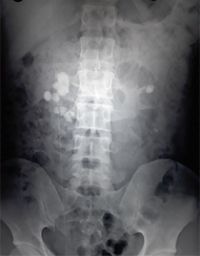Outcome of Percutaneous Nephrolithotomy in Horseshoe Kidneys
Keywords:
Horseshoe kidney, percutaneous nephrolithotomy, renal stonesAbstract
Introduction: The horseshoe kidney is extremely rare, the incidence being one in every 400 - 800 patients. In a recent review of more than 15000 radiographic imaging studies, the incidence was one in every 666 patients. The renal stone formation in horseshoe kidney is around 20-80%. Percutaneous nephrolithotomy is the most accepted modality of treatment . This study was carried out to find the outcome of percutaneous nephrolithotomy in horseshoe kidneys.
Methods: Between May 2013 and November 2017, 11 adult patients (12 renal units) with stones in horseshoe kidneys underwent percutaneous nephrolithotomy in the department of urosurgery, Kathmandu Medical College and Teaching Hospital and were evaluated for the operating time, stone free rate , complications and hospital stay. Data analysis was done using Statistical Package for the Social sciences (SPSS) Version 20. Categorical data were analysed by using Fisher exact test.
Results: The mean age of the patients was 30.9 years (SD = 10.3) and the mean stone burden was 385.83 mm2 (SD = 331.3). The overall stone free rate was 83.33%. The two patients with residual stones when counselled for Extracorporeal shock wave lithotripsy, refused for it and decided to be on follow up. No auxiliary procedure was done. The complications noted were of Clavien-Dindo grade I and II. No pleural or bowel injury was seen. One patient needed blood transfusion.
Conclusions: Percutaneous nephrolithotomy is safe and effective in the management of stones in horseshoe kidneys. It does not carry increased risk than reported in normal kidneys.
Downloads

Downloads
Published
How to Cite
Issue
Section
License
The Journal of Lumbini Medical College (JLMC) publishes open access articles under the terms of the Creative Commons Attribution(CC BY) License which permits use, distribution and reproduction in any medium, provided the original work is properly cited.JLMC requires an exclusive licence allowing to publish the article in print and online.
The corresponding author should read and agree to the following statement before submission of the manuscript for publication,
License agreement
In submitting an article to Journal of Lumbini Medical College (JLMC) I certify that:
- I am authorized by my co-authors to enter into these arrangements.
- I warrant, on behalf of myself and my co-authors, that:
- the article is original, has not been formally published in any other peer-reviewed journal, is not under consideration by any other journal and does not infringe any existing copyright or any other third party rights;
- I am/we are the sole author(s) of the article and have full authority to enter into this agreement and in granting rights to JLMC are not in breach of any other obligation;
- the article contains nothing that is unlawful, libellous, or which would, if published, constitute a breach of contract or of confidence or of commitment given to secrecy;
- I/we have taken due care to ensure the integrity of the article. To my/our - and currently accepted scientific - knowledge all statements contained in it purporting to be facts are true and any formula or instruction contained in the article will not, if followed accurately, cause any injury, illness or damage to the user.
- I, and all co-authors, agree that the article, if editorially accepted for publication, shall be licensed under the Creative Commons Attribution License 4.0. If the law requires that the article be published in the public domain, I/we will notify JLMC at the time of submission, and in such cases the article shall be released under the Creative Commons 1.0 Public Domain Dedication waiver. For the avoidance of doubt it is stated that sections 1 and 2 of this license agreement shall apply and prevail regardless of whether the article is published under Creative Commons Attribution License 4.0 or the Creative Commons 1.0 Public Domain Dedication waiver.
- I, and all co-authors, agree that, if the article is editorially accepted for publication in JLMC, data included in the article shall be made available under the Creative Commons 1.0 Public Domain Dedication waiver, unless otherwise stated. For the avoidance of doubt it is stated that sections 1, 2, and 3 of this license agreement shall apply and prevail.
Please visit Creative Commons web page for details of the terms.



